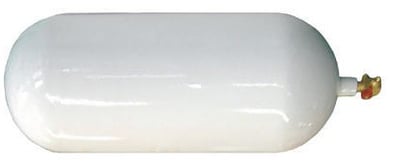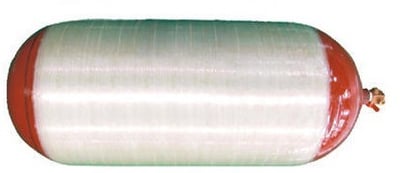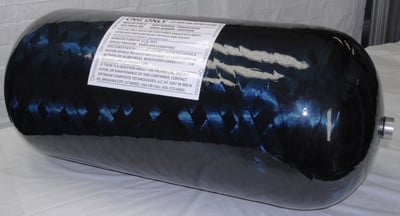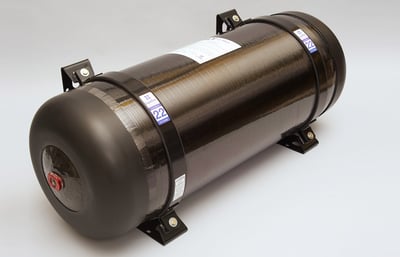The single most expensive component in your CNG conversion will be the high-pressure CNG fuel tank, also known as the “cylinder”.
There are several sizes and types of tank to choose between, the most common of which (for trucks) is a 21″ x 60″ cylinder with capacity for about 20 gallons of CNG.
A Type 4 carbon fiber tank of this size costs around $4,000 and will last for 20 years.
The tank usually mounts in the truck bed behind the cab where a toolbox would go.
Cylinder Specs
CNG cylinders are used all over the world for many different applications.
Globally, most vehicle cylinders are rated for a working pressure of 3,000 psi (200 bar) but, in the US, the standard pressure rating for vehicle cylinders is 3,600 psi (250 bar).
Cylinders usually hold between 5 and 20 gallons of gasoline equivalent (GGE). One GGE will yield the same mileage as a gallon of gasoline, assuming your CNG conversion kit has been installed correctly.
The capacity of the cylinder will vary slightly due to temperature and the materials from which it is constructed. For example, carbon fiber tanks retain more heat than steel tanks, which can reduce their capacity due to fuel expansion under warmer conditions.
Each cylinder carries an expiration date and will usually last 15-20 years, although visual inspections are required every 36,000 miles or 3 years, whichever comes first.
CYLINDER TYPES
Type 1: All Steel

All steel cylinders are the most common, relatively cheap, but very heavy. A full Type 1 cylinder can weigh over 350 pounds.
However, steel cylinders are the most likely to pass safety inspections as they can exhibit some wear-and-tear, including dings and scratches, whereas other tank types are held to a higher standard.
Type 2: Hoop Wrapped Composite

Type 2 cylinders feature a metal liner and a composite wrap along the straight sides.
The metal liner is designed to withstand the operating pressure by itself, while the wrap provides additional support and safety.
This type of tank is a compromise between the heavy Type 1 and much lighter Type 3 and 4 cylinders.
Type 3: Fully Wrapped Composite

A Type 3 cylinder features a seamless metal liner that is completely wrapped - on all surfaces - with composite reinforcement.
The wrap provides almost all of the strength, while the metal liner ensures gas-tight integrity.
Type 3 cylinders are commonly used for SCUBA and medical oxygen storage as they are much lighter than Types 1 and 2.
Type 4: Fully Wrapped Non-Metallic Liner

The most expensive type, costing $3-5,000, Type 4 cylinders feature a plastic liner and a full wrap of carbon fiber.
The liner acts only as a permeation barrier.
Even large (15-20 GGE) Type 4 tanks only weigh about 100 pounds when empty. Their strength comes from the carbon fiber wrapping.
They aren’t actually gas tight but leak so slowly that gas permeation is almost undetectable and does not represent a hazard.
Type 4 cylinders are fitted with impact protection on the domes for added strength.
This is the most commonly used tank for small cars and for buses, where weight is important.
HOW TO CHOOSE?
For those on a tight budget, a heavy but durable steel tank (Type 1) makes sense.
Type 3 tanks are an excellent choice if the overall weight of the tank will make a difference to your vehicle’s performance but you’re not in the market for the ultimate solution.
That solution, of course, is a Type 4 tank, which is the lightest option and will maximize your CNG capacity while giving you the best overall mileage. You’ll pay more for the privilege and you’ll want to make sure your tank is securely mounted and protected to avoid any risk of damage.
There’s no right or wrong answer here – just a tank that’s right for each application and budget. We’ll be happy to advise on your individual situation, as well as guiding you to a recommend supplier and tank installer.


